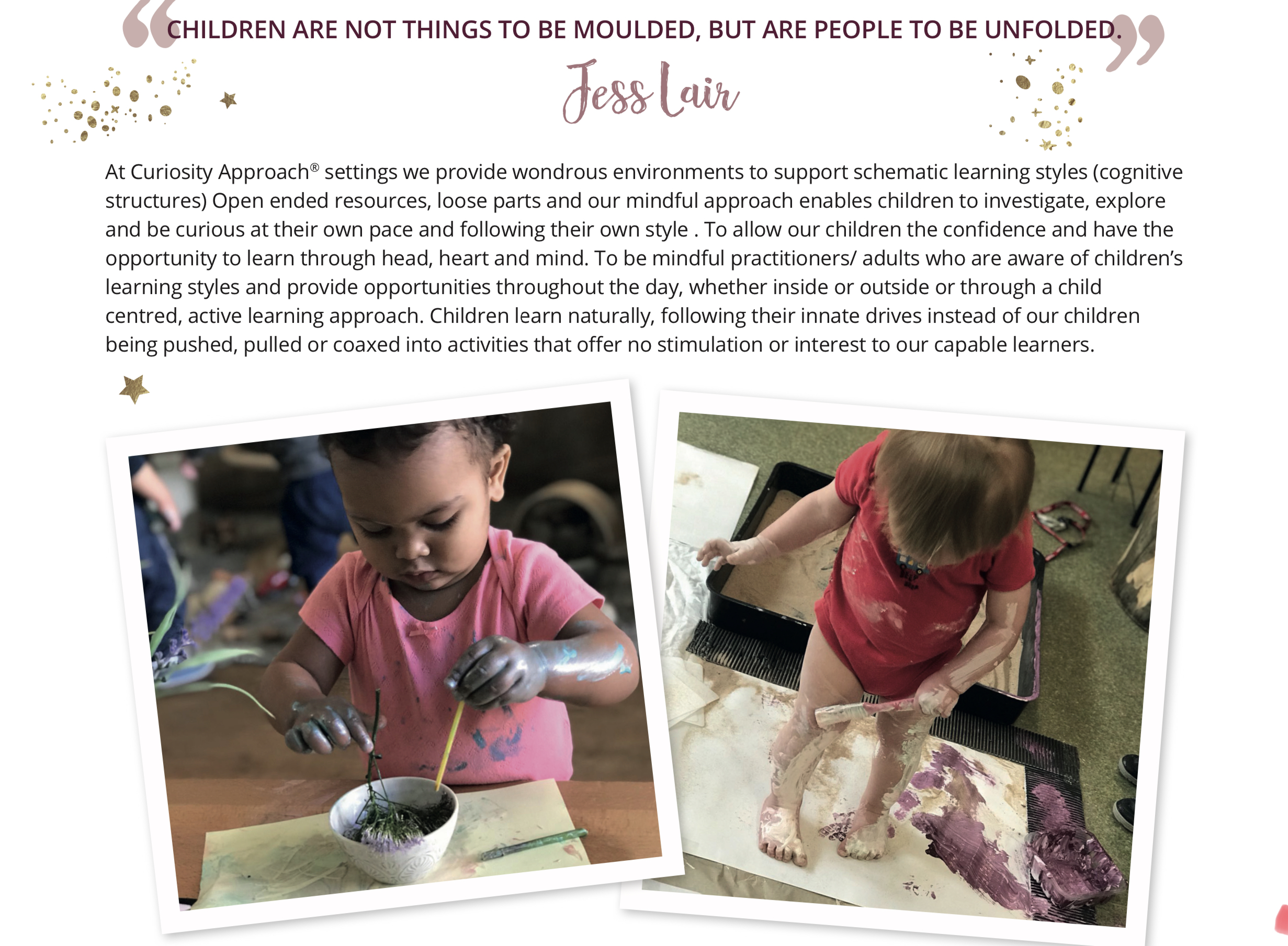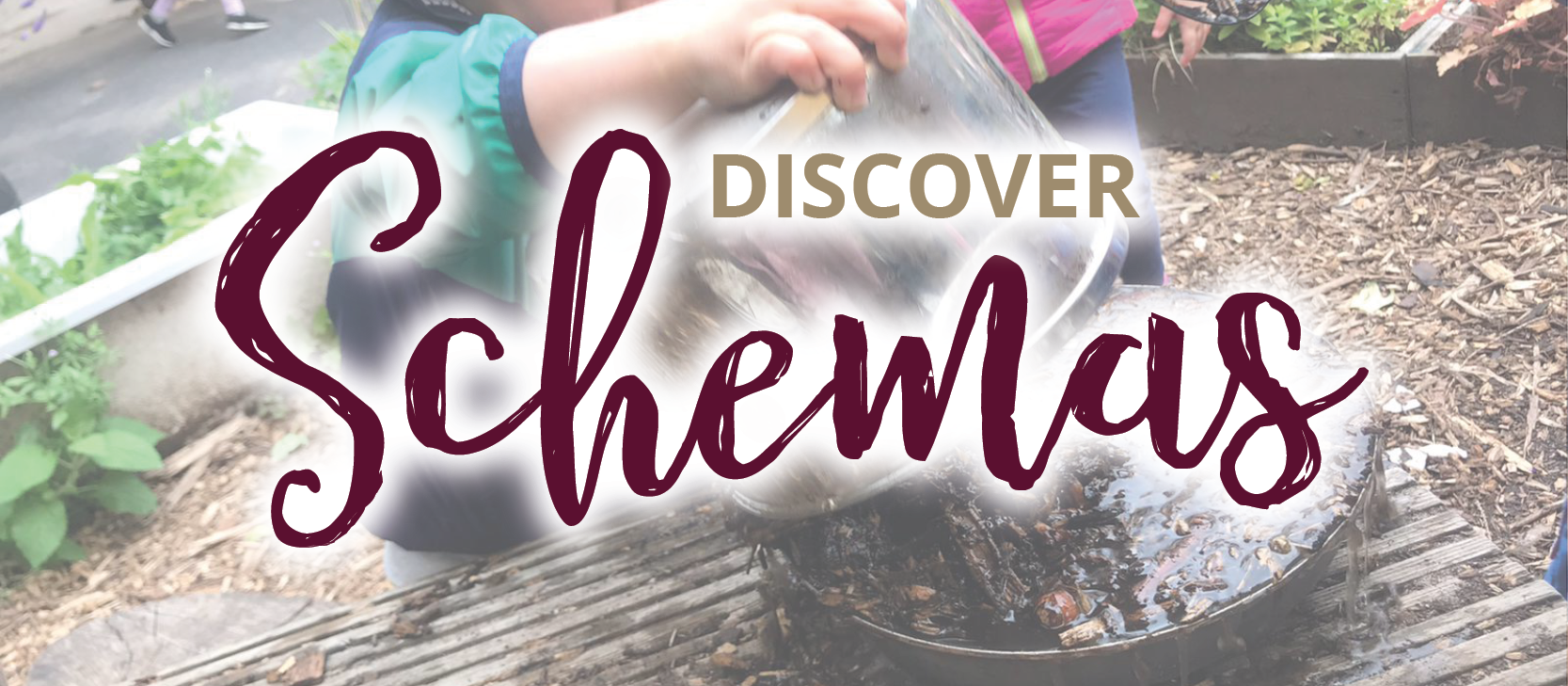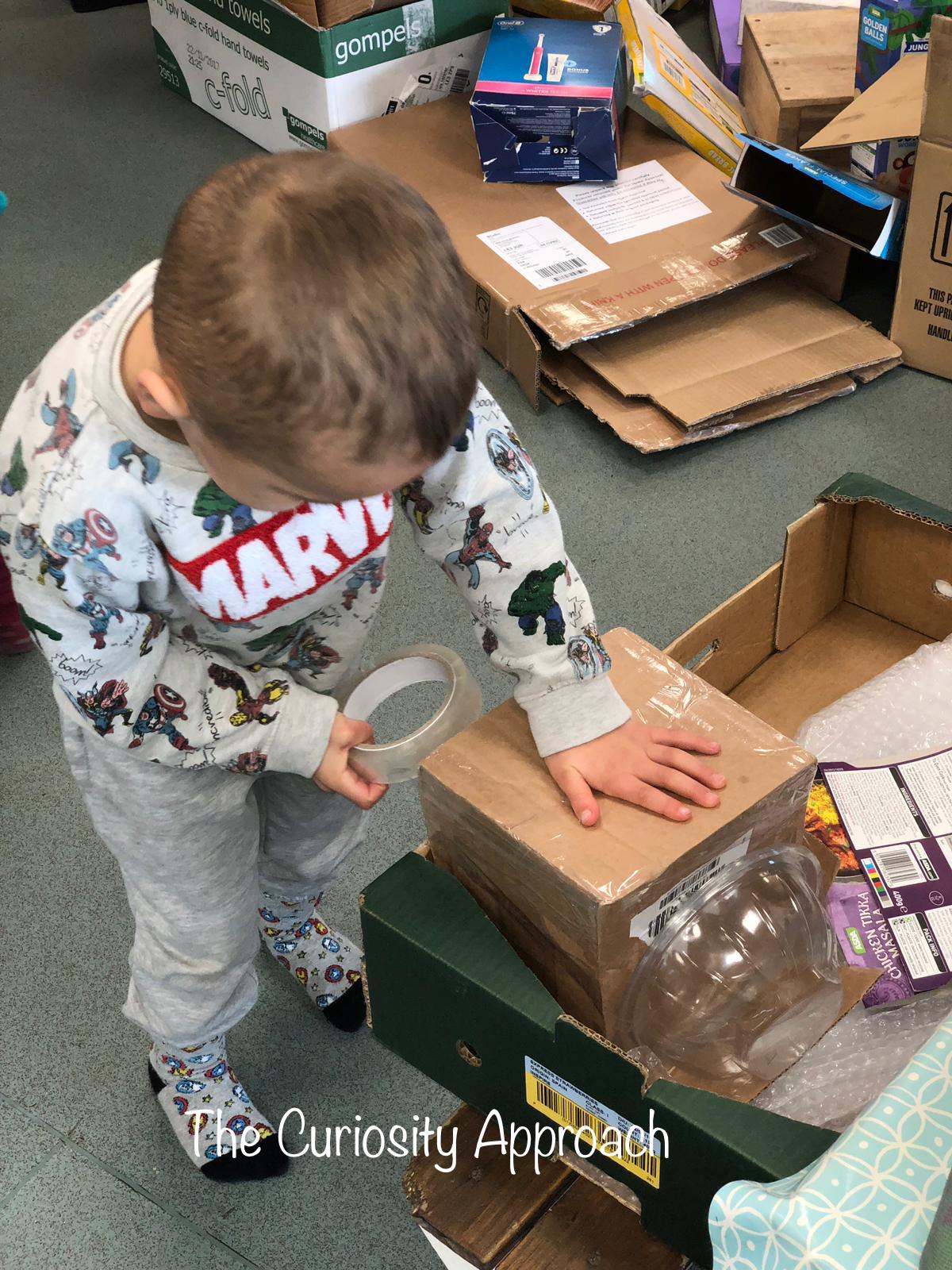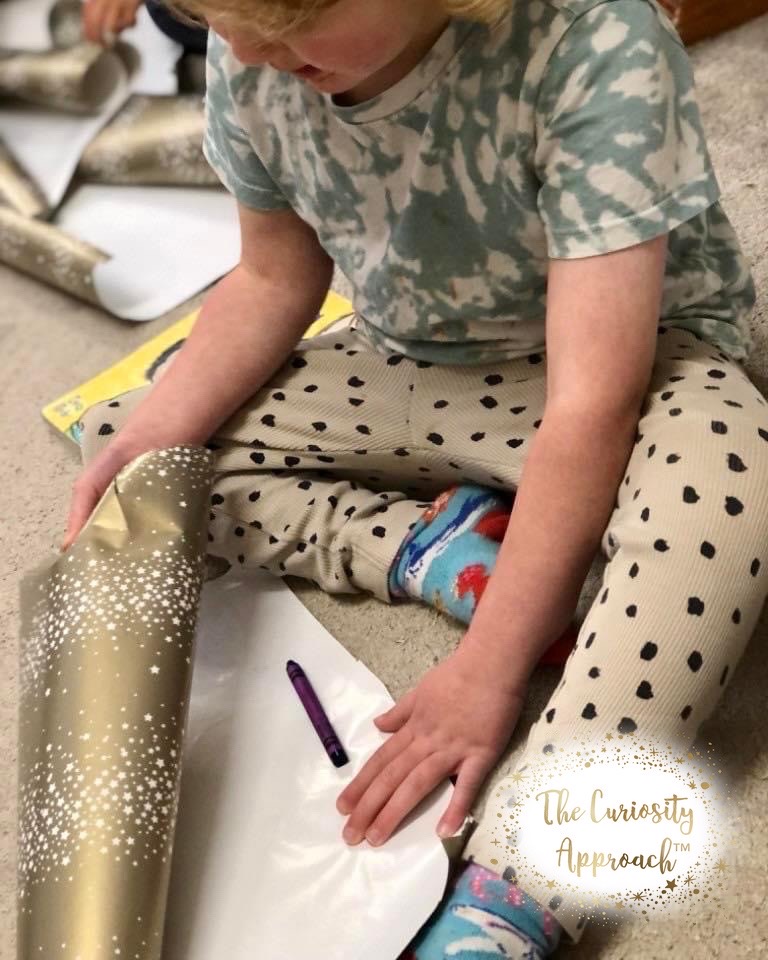Schematic learning styles
Release Date: January 2, 2023
Last Updated: October 27, 2023
At the Curiosity Approach® as mindful educators of children, whether as a parent or key person it is important that we understand how children learn through curiosity and play. We must be consciously aware of how children play. To recognise, observe and understand the amazing patterns of behaviour of these curious little learners as they explore, discover and develop. Play is where magic happens!
What is a schema? A schema or schematic learning style are described as repeated patterns that allow children to make sense of the world around them. We believe that a simple way to consider a schema is an URGE!
An urge to explore, discover and learn, children will do this through repeated patterns of behaviour.
‘Bruce 1997 described schemas as patterns of linked behaviour which the child can generalise and use in a whole variety of different situations. It is best to think of schemas as being urges, an intrinsic desire or motivation to do something over and over again.’
Some children may display a prolific dominant schema or children may play and learn to show a group or ‘cluster’ of schemas. Some children may display no schemas at all. Every child is unique and different and its wonderful to see how each child learns and plays.
‘Specific schemas may be more evidential or dominant with some children than others and often, schematic learning styles may fade in and out, or replaced by another style of learning. Children are all individuals and we must take the time to notice the patterns in learning and helping to understand children’s uniqueness, understanding what motivates them to become engaged, play and learn.’ (1)
Parent partnership
It is important that through parent partnership and those important links with Early years settings, we communicate about children’s patterns of behaviour, as it helps us all create a clearer and bigger picture of what children are interested in, why children do what they do and what motivates them? Only by working together can we begin to offer our curious learners experiences and opportunities to meet their interests and capture their curiosity and attention and ultimately help children learn and develop in a way that motivates, interests them and meets they learning styles.
CHILDREN ARE NOT THINGS TO BE MOULDED, BUT ARE PEOPLE TO BE UNFOLDED.
Jess Lair

You can get this blog as a PDF DOWNLOAD from our Curiosity Approach® APP
At Curiosity Approach® settings we provide wondrous environments to support schematic learning styles (cognitive structures) Open ended resources, loose parts and our mindful approach enables children to investigate, explore and be curious at their own pace and following their own style . To allow our children the confidence and have the opportunity to learn through head, heart and mind. To be mindful practitioners/ adults who are aware of children’s learning styles and provide opportunities throughout the day, whether inside or outside and through a child centred, active learning approach. Children learn naturally, following their innate drives instead of children being pushed, pulled or coaxed into activities that offer no stimulation or interest to our capable learners. At The Curiosity Approach®, we believe there is no need to follow topics or themes and follow the schematic learning styles or URGES of children instead.
Only by allowing children the opportunity to take charge of their own learning style can we hope they will demonstrate high levels of engagement and well-being and characteristics of effective learning.
At the Curiosity Approach® we are influenced by Steiner and Montessori (together with Reggio and Te Whàriki ) Bringing these wonderful ingredients together to inspire our curious learners of the future. In previous early education, nothing much was known about schematic learning styles, however these early years pioneers ‘Steiner and Montessori’, together with Frobel, Piaget and many more were excellent observers of children and were in tune with children’s intrinsic development. They instinctively knew to offer high quality learning environments which facilitated children the opportunity to learn to follow what motivates them most. At the Curiosity Approach® it’s our aim to inspire practitioners to in turn inspire our young children to become the ‘thinkers and doers of the future.’
Like our inspirational educational pioneers of a bygone era, and as mindful and knowledgeable educators of today, we need to know when to step back and take time to observe our wonderful learners, to see their patterns of behaviour in play and to react and fully acknowledge them. To offer high standards of teaching and learning, to respect the children’s learning style and to provide opportunities to enhance their enthusiasm, to provide provocations to learning that fuel their interest and facilitate continued learning and development.
LET THE CHILD BE THE SCRIPTWRITER, THE DIRECTOR AND THE ACTOR IN HIS OWN PLAY.
Magda Gerber

Our Curiosity Approach® Ambassadors offered ‘Discovery Sessions’ in areas up and down the UK- See if there is an ambassador in your local area SEE LINK TO FIND OUT MORE https://www.thecuriosityapproa...
Types
Hopefully the following brief overviews of schematic learning styles and their characteristics will give you an insight into what
to look for when observing our incredible capable learners. As mentioned previously you may see a ‘ cluster ‘ of these or one
may be more dominate than another schema. Some children may show no obvious learning style and this is completely ok.
Every child is learning continually and utterly unique in their learning and development.
Some of the most common types of observed schema include –
• Trajectory
• Transporting • Rotation
• Connecting
•Transporting
*Enclosing
• Positioning • Enveloping • Orientation
• Transforming
Trajectory
Children will be fascinated with the horizontal, vertical and diagonal movement of items and themselves. They may spend lot of time throwing or dropping items. Babies can be observed reaching out for objects, kicking their legs, opening and closing their hands, waving arms up and down or side to side, throwing, pulling, pushing, pointing. Sometimes its easy to misinterpret children's play and behaviour negatively. We get frustrated when children like to knock things over or constantly throw things, let us understand behaviour, instead of just trying to manage it. To provide a rich ply space full of opportunity to play and engage meeting their own learning styles.
We can support children with this by providing throwing, rolling and catching games, provide children with balls, bean bags, balloons, cars or wind-up toys. At the Curiosity Approach®, we love to use guttering or drain pipes, encourage children to create ramps to roll items down. See our further blog ”why do some children throw things?” https://www.thecuriosityapproa...
Transporting
Have you ever noticed that children are fascinated with moving items/objects from one place to another? They may like to place items within containers to move them around e.g. filling handbags, buckets and baskets. Filling up containers in the garden with sand or and moving it from place to place. Perhaps they love using a wheelbarrow to transport the sand, dirt or large collection of items around the garden? Children may have pockets or hands constantly full of items they like to transport around the home or nursery.
We can support this by providing children with empty bags, purses, boxes, buckets with handles, wheelbarrows, and plastic bottles.
Once again let us watch children in their play. See what they are DOING- instead of what they are playing with! Do you have a child who just loves transporting the play-dough across the room to the home corner? They have an URGE to act out their ideas, thoughts and thinking. Let’s reflect and ensure our Early years settings are YES environments and that we understand the play styles of children. Allowing them to follow their schematic learning styles ( OR do we sadly stop children’s play in its tracks? Read the blog below to reflect further.
Here is another blog “ Leave the play dough on the play dough table’ https://www.thecuriosityapproa...
Rotation
Children may be fascinated with objects that turn around, twist, spin and even enjoy moving their own bodies displaying these movements. Spinning around in spirals or rolling themselves across the floor.
We can support children with this by providing children with spinning resources, balls and access to door knobs, handles or hardware materials on a investigation board, that they are able to twist and turn – e.g. turning a dimmer switch.
• A recycled bike wheel or salvaged tyres from a Go Cart centre allow children the opportunity to roll and spin resources on a larger scale.
• Set up rotational toys, windmills that spin in the wind.
• Physical gross motor movements of rolling down a grassy bank or spinning and turning safely.
Quite often we can mistake a rotation schema as an interest in play cares or vehicles, misinterpreting what children like to play with! A schema is NOT about WHAT children are playing WITH. It’s about what children are DOING in play. Children are fascinated with the spinning and turning of the wheels, fascinated to watch and discover how things work. Notice an indication of a rotational schema throughout play. As mentioned above do children like to spin and turn? Like to spin the wheels of the upturned pushchair, bike, wheelbarrow or pram. Notice what children are doing, instead of just what they play with.
Connection
Children observed exploring this schema will become deeply engaged and spend extended periods of time connecting objects and items together. You may observe children as they take care to join items, such as cars or small world animals together, ensuring that each one touches the other. The resources they connect can be anything and everything!
We could support this by providing children with a selection of loose parts, glass beads natural materials? Use recycled materials to allow children the opportunity to construct and create. To enable children the opportunity to connect, stick or glue together. Provide a range of tape, string, duct tape. Scissors clips – anything that children could use to connect materials together.

Enclosure/containing
Children may spend time filling up and emptying all kinds of authentic pots pans or ceramic containers. They will become
fascinated with climbing into large boxes and sitting in them, enjoining the feeling of being surrounded and enclosed in a space. Children often become eager to empty bags, boxes
drawers, envelopes etc. and refill with anything!
We can support this by providing large boxes, crates or baskets that they can empty or refill with loose parts or open-
ended resources. Sand, water, beads etc. could be used with containers or bottles with funnels and children will have
a great time filling and emptying them. Provide authentic
resources to allow children opportunity to manage risk and handle eclectic materials. The use of drain pipes. Colanders
and funnels to refill containers and boxes. Tea parties are a great opportunity for filling tea cups, tea pots or pans.
Positioning
A child may be seen to order of sort themselves, items or resources. They might put items on their heads or spend a lot of time trying to balance toys on furniture. Children showing this schema may prefer their food separated on the plate and not mixed up or close together e.g. their custard next to their sponge not over it and may often spend time stretched on the floor or under the tables.
We can support this by providing children with lots of space or assistance in ordering or sorting items in specific ways, e.g. by size, colour or type. organising pots and pans in the mud kitchen or organizing the cutlery in the home corner, sorting shells in order of shape and size.
Enveloping
Children will enjoy wrapping themselves up in gorgeous pieces of material or wrapping objects up in fabrics, materials or paper. Children become fascinated with making dens and playing hide and may often be observed crawling through tunnels, into wondrous Hygge places
or sitting in them for long periods of time. They might also spend a lot of time painting a beautiful picture and then covering their entire work with one colour. Painting all over their creation and filing the entire page, enveloping it in one colour!
We can support children with this by providing your child with floaty scarves, saris etc., a variety of different materials, hats, empty boxes/bags and lots of space to make dens. Provide large and small envelopes
and paper for children to investigate the concept of putting letters into envelopes. Folding up paper and putting it inside.
See further blog on Enveloping schema https://www.thecuriosityapproa...
Orientation
Children will have the urge to hang upside down, get the view from a different vantage or view
point. To lie off the sofa or chair with their head on the floor, viewing things from a different perspective.
We can support children to do this by using mirrors in areas of play allowing children to view objects and resources from another dimension. Provide to magnifying glasses or peep holes for children to explore new ways to view things.
Transforming
Children may like to experiment or investigate with the changes of the resources when they are altered with, e.g. mixing paint colours
together, adding ingredients to tea making facilities, fruit infused tea, a range of herbal tea bags. Food colouring when making
playdough or adding items for sensory smell and texture e.g. herbs and spices.
We can support children with this: by providing lots of opportunities for them to investigate and manipulate resources,
e.g. lots of opportunities to be curious, investigate and use open-ended resources e.g. potion stations, using pestle and
mortars, mixing a range of ingredients to create concoctions and exciting mixtures.
It is important as CURIOUS practitioners that we take time to recognise and understand the learning styles of children, only through understanding children’s specific interests and what motivates them to learn can we provide effective provocations for learning.
Those opportunities for teaching and learning which inspire children to engage in deep levels of thinking. To be curious about the world around them and make sense of things. To assimilate meaning to knowledge and information.
Our amazing little learners are providing us with useful messages, demonstrating patterns of behaviour, which we need to actively assess and use to influence learning. We need to be mindful and present in the moment, so that we do not miss these incredible messages that are subconsciously displayed.
Be open to acknowledge, to see and understand the value of schematic learning styles and be motivated to offer high levels of teaching, scaffolding our children’s learning development in a fun, exciting way, that meets their unique and individual needs and interests.
Wait... watch and wonder!
(Information taken from – Again! Again! Understanding schemas in young children. Edited by Sally Featherstone. ISBN 978-1-905019-95-3)https://www.communityplaything...
Copyright protected
Curiosity is one of the most permanent and certain characteristics of a vigorous intellect’
Quote by Samuel Johnson
Have you purchased our Curious resource that is all about schemas? It opens into an A2 poster that you can display at your setting Click below
https://www.thecuriosityapproach.com/.../issue-03-schemas
Take the score card quiz today https://thecuriosityapproach.s...
This blog and images are the intellectual property of The Curiosity Approach® and subject to copyright protection



